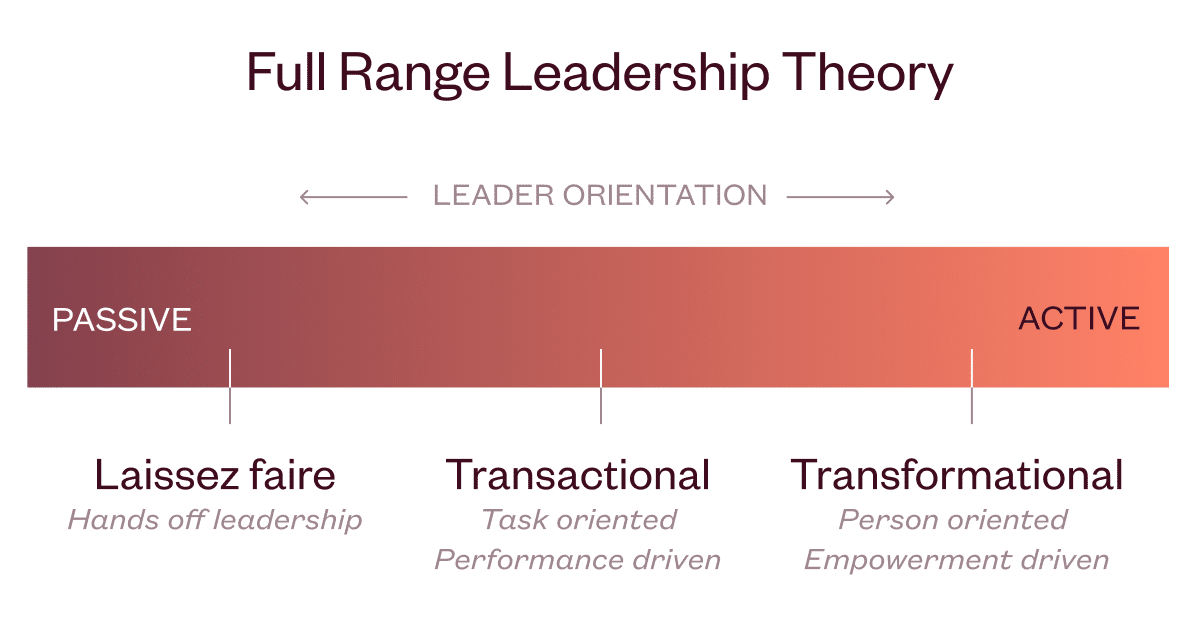There is nothing more daunting than uncertainty. And we get a lot of it living in our volatile, uncertain, complex, and ambiguous (VUCA) world. For leaders, this means it’s usually impossible to gather all the information and data needed to make decisions. So how do we make decisions when the future is ever evolving and unpredictable? Is it better to take a risk with limited information, trusting that our decision will work out like a shot in the dark? Or should we play it safe, waiting until things become clearer (and risk losing a window of opportunity)?
This kind of decision making is something we’ve all become well acquainted with, especially during the pandemic and today with continued economic uncertainty. As we face the difficulty of making decisions when the future is unclear, leaders have a unique opportunity to guide others in these uncertain times.
How can leaders best lead under uncertainty?
We can look to a prominent theory on leadership, Full Range Leadership Theory, to conceptualize the different types of roles a leader can take in these circumstances. This theory depicts leadership on a scale, from a hands off approach, laissez faire leadership, to an approach that empowers others, transformational leadership.

While many organizations may see the pitfalls of a fully hands off approach during uncertain times–for instance, debating whether this is really leadership at all–others may look to transactional leadership as a solution. This style of leadership tends to be task oriented and focuses on rewarding or punishing employees for their work performance. The relationship is basically an exchange of performance for reinforcement, motivating little beyond the leaders’ expected output.
Transformational leadership, on the other hand, is an approach focused on inspiring and empowering others.¹ Employees under this style of leadership are more likely to be more committed to their organizations as this approach seeks to equip and not direct.
In a study of executives from 48 Fortune 500 companies, David Waldman and his colleagues also found that transformational leadership was especially effective under environmental uncertainty, as it related to increased performance and net profit margin in uncertain circumstances.
Why is this leadership style so influential? In short, transformational leaders seek to understand their employee’s needs, and help develop and challenge them to make better decisions, ultimately cultivating leadership and decision-making skills in others.
What is cultivation? And, why does it matter for leaders?
At Torch, we capture this dimension of leadership in our 360 assessment with the behavioral domain of cultivation. There are nine total domains in the 360 that were generated from a statistical method to identify the most significant leadership skills in the literature. Torch coachees assess themselves on these dimensions and then ask coworkers and their manager to rate them as well. This process generates a more holistic view of themselves for development. The domain of cultivation, in particular, describes the coachee’s ability to help others to “push past their comfort zones to grow and achieve their professional goals.” And what’s more uncomfortable than making decisions under uncertainty?
Leaders who are strong in this domain are able to facilitate this growth for their teams by taking an interest in their direct reports’ development, and guiding them towards meeting their goals and aspirations. Leveraging the strength of cultivation shifts the leader’s role from primarily directing employees to empowering them.
It’s clear that equipping and enabling others is a difficult leadership skill to master–for everyone. In fact, in 2020 and in 2021, cultivation was one of the top 3 leadership domains that Torch coachees most frequently sought to improve upon when setting learning goals. With the demand for leaders to inspire their teams during these past two challenging years, it’s unsurprising that this domain emerged as a priority. Further, when cultivation is a potential area of improvement, there is great effort put towards improving in this skill. Among the users who made it a goal to improve in cultivation from January 2020 to July 2022, 13% of those users set multiple cultivation related goals.
How can leaders best cultivate others?
Applying skills from coaching can help leaders and managers alike grow in this strength of cultivation. Rick Bommelje, a professor at Rollins College, coach, and expert on leadership and listening, offers the following three recommendations:
- Guide the decision making process by asking questions. In lieu of offering an answer, leaders can ask questions to probe thinking and gain clarity on the problem at hand.
- Help set clearer and more effective goals. Leaders can leverage the acronym SMART (specific, measurable, achieve, realistic, and timebound) to frame effective goal setting.
- Offer feedback or “feedforward” to improve. Leaders can focus on how past outcomes can inform better future decisions.
Good leadership offers tools and resources to employees–this is especially needed as we navigate a constantly changing and evolving world. These are three actions that leaders can take to provide some structure, clear the way, and practice cultivation.
Footnotes
¹ Muchinsky, P. M., & Culberston, S. S. (2016). Leadership. In Psychology Applied to Work (11th ed., pp. 394–424). Hypergraphic Press.

